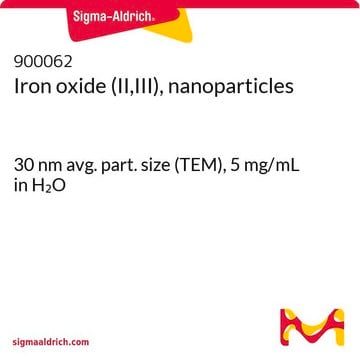720712
Iron(III) oxide, dispersion
nanoparticles, ≤110 nm particle size, 15 wt. % in ethanol
Synonym(s):
Iron oxide in ethanol
Sign Into View Organizational & Contract Pricing
All Photos(2)
About This Item
Empirical Formula (Hill Notation):
Fe2O3
CAS Number:
Molecular Weight:
159.69
MDL number:
UNSPSC Code:
12352303
PubChem Substance ID:
NACRES:
NA.23
Recommended Products
form
nanoparticles
concentration
15 wt. % in ethanol
particle size
≤110 nm
SMILES string
O=[Fe]O[Fe]=O
InChI
1S/2Fe.3O
InChI key
JEIPFZHSYJVQDO-UHFFFAOYSA-N
Looking for similar products? Visit Product Comparison Guide
Signal Word
Danger
Hazard Statements
Precautionary Statements
Hazard Classifications
Eye Dam. 1 - Flam. Liq. 2
Storage Class Code
3 - Flammable liquids
WGK
WGK 1
Certificates of Analysis (COA)
Search for Certificates of Analysis (COA) by entering the products Lot/Batch Number. Lot and Batch Numbers can be found on a product’s label following the words ‘Lot’ or ‘Batch’.
Already Own This Product?
Find documentation for the products that you have recently purchased in the Document Library.
Customers Also Viewed
Alice Panariti et al.
Journal of biomedical nanotechnology, 9(9), 1556-1569 (2013-08-29)
Magnetic nanoparticles have emerged as important players in current research in modern medicine since they can be used in medicine for diagnosis and/or therapeutic treatment of diseases. Among many therapeutic applications of iron-based nanoparticles, drug delivery and photothermal therapy are
J Sangeetha et al.
Journal of biomedical nanotechnology, 9(5), 751-764 (2013-06-28)
We present methodologies to functionalize iron oxide (Fe3O4) nanoparticles with biosurfactants and biocompatibility results. Positively charged Fe3O4 nanoparticles of average hydrodynamic size -26 nm is functionalized with four different molecules of interest, viz., surfactin, rhamnolipid, polyethylene glycol (PEG) and dextran.
Andrew Pratt et al.
Nature materials, 13(1), 26-30 (2013-11-05)
Geometry and confinement effects at the nanoscale can result in substantial modifications to a material's properties with significant consequences in terms of chemical reactivity, biocompatibility and toxicity. Although benefiting applications across a diverse array of environmental and technological settings, the
Rajenahally V Jagadeesh et al.
Science (New York, N.Y.), 342(6162), 1073-1076 (2013-11-30)
Production of anilines--key intermediates for the fine chemical, agrochemical, and pharmaceutical industries--relies on precious metal catalysts that selectively hydrogenate aryl nitro groups in the presence of other easily reducible functionalities. Herein, we report convenient and stable iron oxide (Fe2O3)-based catalysts
Tomoko Satomi et al.
Journal of nuclear medicine : official publication, Society of Nuclear Medicine, 54(6), 999-1004 (2013-05-15)
Various noninvasive imaging methods have been developed to evaluate atherosclerotic plaques. Among them, (18)F-FDG PET and MR imaging with ultrasmall superparamagnetic iron oxide particles (USPIO) have been used to quantify plaque inflammation. Both methods are based on the efficient uptake
Our team of scientists has experience in all areas of research including Life Science, Material Science, Chemical Synthesis, Chromatography, Analytical and many others.
Contact Technical Service




